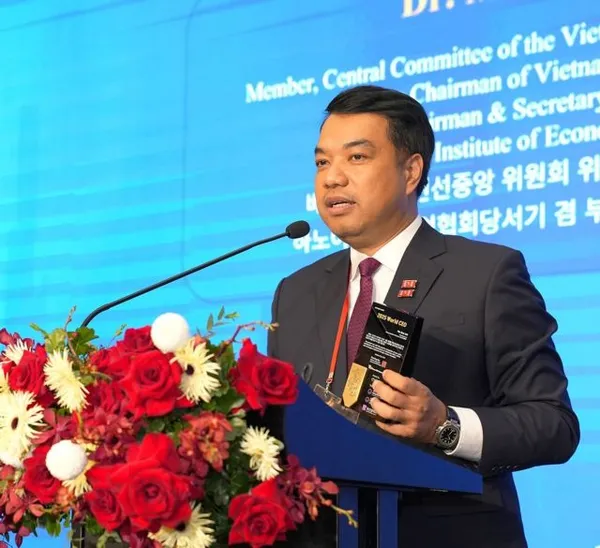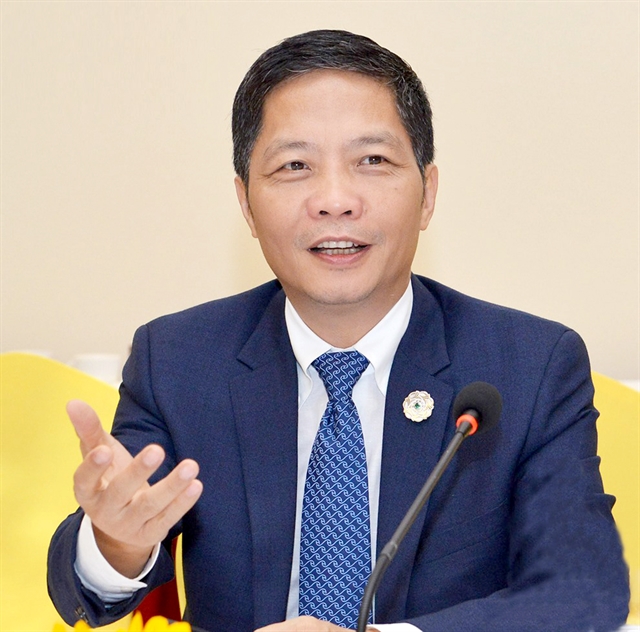 Talking Shop
Talking Shop

Although the COVID-19 pandemic continues to be unpredictable in many ASEAN countries, Việt Nam has actively proposed and participated in regional initiatives to promote economic recovery and maintain production and supply chains both in the region and the world.

|
| Minister of Industry and Trade Trần Tuấn Anh. |
Although the COVID-19 pandemic continues to be unpredictable in many ASEAN countries, Việt Nam has actively proposed and participated in regional initiatives to promote economic recovery and maintain production and supply chains both in the region and the world.
Minister of Industry and Trade Trần Tuấn Anh spoke to the press about ASEAN’s post-pandemic economic recovery plan on the sidelines of the 52nd meeting of ASEAN Economic Ministers (AEM-52) which was held on August 25.
In the context of a prolonged COVID-19 pandemic, would you share the priorities given by countries in the AEM-52 and ASEAN Free Trade?
2020 is a very special year when the impacts of the COVID-19 pandemic have greatly affected economic development, requiring the addition of new priorities to the working agenda of the Chair of ASEAN.
The first is the disruption of supply chains that have largely affected ASEAN countries.
Since most ASEAN countries are export-oriented ones that play an important role in regional and international supply chains, they are heavily dependent on fuel sources as well as supporting industrial products that provide inputs for their local production.
Along with that, disease prevention and control measures have affected the circulation of product lines and goods, many of which are essential for life as well as for pandemic prevention and control.
Therefore, ASEAN countries must have solutions to further strengthen the resilience of their economy as well as the ability to cope with the new situation.
As Chair of ASEAN in 2020, Việt Nam has proactively co-ordinated with other ASEAN members and the ASEAN Secretariat to map out many new contents for high-level conferences and co-operation mechanisms between ASEAN and ASEAN+3 partners – Japan, China, the Republic of Korea, as well as other partners, so as to ensure the goals and requirements in fighting the pandemic while facilitating economic development of the bloc.
The goal in 2020 is to combine long-term goals, including the ASEAN Economic Community Blueprint 2025, with the 13 important initiatives proposed by Việt Nam and already approved within ASEAN co-operative framework.
It is necessary to realise short-term goals to help address immediate difficulties of the ASEAN economy, having impacts on firms which are mostly small and medium-sized enterprises (SMEs).
All of these contents have been fully demonstrated in the framework of the ASEAN Leaders' Summit in April 2020 or AEM-52, Economic Ministers Meeting ASEAN+3, Economic Ministers of ASEAN-Korea Meeting.
Furthermore, the issuance of action plans, importantly the statements of ASEAN leaders in response to COVID-19, and the Declaration of ASEAN Economic Ministers aimed to enhance response to the pandemic.
Specifically, the Hà Nội Action Plan, Joint Statement of Economic Ministers of ASEAN countries, Joint Statement between ASEAN-South Korea Economic Ministers were issued on strengthening connectivity, maintaining and restoring supply chains.
Most recently, the AEM-52 adopted a long-term programme in ASEAN economic recovery activities with solutions to achieve the mentioned objectives.
What are the meanings of Việt Nam's initiatives brought out in the framework of this meeting?
With these initiatives, Việt Nam has actively researched and proposed in the content of the AEM-52 to respond to the COVID-19 pandemic.
In addition, the initiatives were also proposed in the Joint Statement between the ASEAN Economic Minister and the Korean Economic Minister, enhancing the supply chain connectivity; served for the ASEAN Leaders' Summit in the Joint Statement on the Prevention, Control and Response to COVID-19.
All major contents in the framework were proposed by Việt Nam in co-ordination with ASEAN countries and the ASEAN Secretariat. All countries have agreed on initiatives and contents that Việt Nam has launched.
In addition, the continued strengthening of digital transformation and the application of e-government based on information technology as an important foundation of the Hà Nội Action Plan also received an welcome and very high support from other countries.
Among the 13 initiatives proposed by Việt Nam, two have been completed by the time the AEM-52 was held, which are the building of an ASEAN digital integration index, and connectivity of ASEAN innovation centres.
Other initiatives and priorities are being discussed and implemented in line with goals set for 2020.
Việt Nam is also actively working with other ASEAN members and partners to step up the settlement of remaining issues in negotiations of the Regional Comprehensive Economic Partnership (RCEP), which is one of the priorities on economic cooperation during Việt Nam’s Year of ASEAN Chairmanship.
The completion of economic initiatives and priorities will contribute to promoting ASEAN’s internal strength and enhancing the role of the ASEAN Economic Community, while helping ASEAN proactively respond to non-conventional challenges in the future.
Việt Nam has also made important recommendations in the establishment of a high-level ASEAN task force to study and co-ordinate in developing measures to ensure a dual goal of disease prevention and effective response to COVID-19.
However, the goal of bringing ASEAN economies back to a new normal state must be continued through strengthening co-operation and connectivity both within the region as well as with external partners.
Recommendations of the high-level task force in five major areas have created a very important foundation to build the action programme to restore and continue to develop the ASEAN economy after COVID-19.
Following the Joint Declaration and action plans to prevent the pandemic, Việt Nam will issue a joint statement in AEM-52 aimed at strengthening co-operation between ASEAN and three partners. What message from ASEAN will these statements send out?
ASEAN, regardless of the framework or level, should not go far beyond the common goals of building an autonomous and resilient ASEAN Economic Community.
At the same time, Việt Nam also strengthens and ensures the pivotal role of ASEAN as a major economic partner of all economies in the world. ASEAN is a dynamic and developing economic region.
With total trade of up to US$2.8 trillion and total GDP of over $3 trillion, ASEAN is the world’s fifth largest economy.
In 2019, all ASEAN countries had remarkable growth rates, all among the countries with top GDP growth rates in the world.
In addition, most ASEAN countries, including Việt Nam, are very active members in the process of international economic integration.
Therefore, requirements for declarations and co-operation plans in ASEAN and ASEAN+3 will focus on continuing to support ASEAN in completing institutions in economic governance and trade as well as improving ASEAN's institutional capacity.
On the other hand, these would continue to strengthen and create a connected and completed infrastructure and framework within ASEAN, connecting with the ASEAN+3 economies. In particular, it would secure supply chains, in terms of markets for products and raw materials as well as the technology and human resources market.
It is necessary to strengthen and consolidate the supply chains that Việt Nam already has and increase their resistance and efficiency in ASEAN+3.
Co-operation in ASEAN+3 not only aims to ensure the supply of raw materials right now, but also further strengthen connectivity and institutionalisation to facilitate investment flows as well as mutual market access opportunities of ASEAN and partner countries.
Thus, Việt Nam's goal is to continue to make efforts in promoting the signing of the RCEP Agreement in 2020 in Hà Nội.
It would continue to seek and further strengthen opportunities to connect with potential partners and to create more favourable frameworks for the economy and ASEAN businesses.
It would continue to build funds to enhance development and improvement of the connected infrastructure system within the framework of ASEAN and ASEAN with partners.
In particular, a programme to form a reserve fund of essential commodities for disease prevention and control as well as for people's living needs would be also established. — VNS